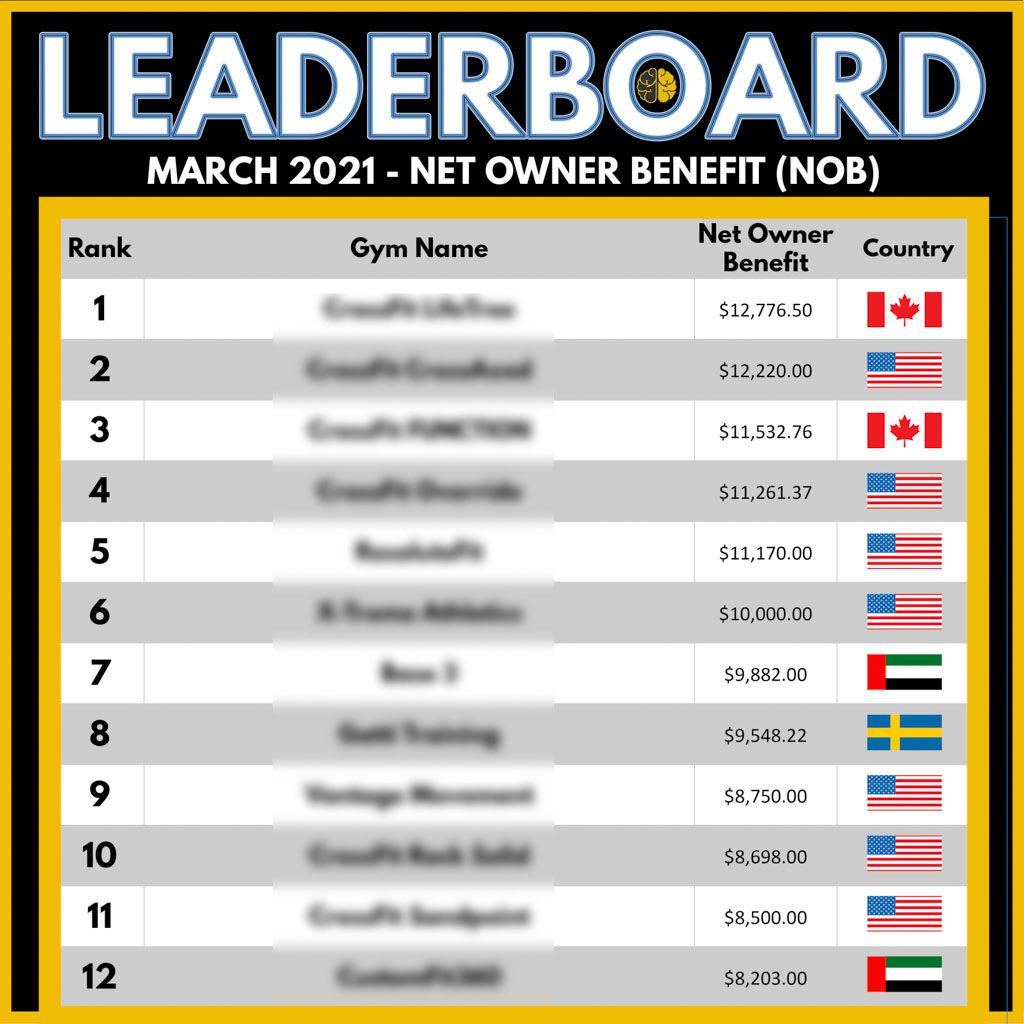Your gym business relies on your intelligent decision-making to be successful, and you can’t make good decisions without knowing your gym metrics.
With every major business move, your time, money and other assets are at stake in a tough business environment with a slim tolerance for trial and error. The basis for your decisions and strategies must be sound.
A data-driven business decision-making process eliminates the need for ballparking and guesswork. So, gym metrics can be your best resource for making your fitness business more profitable. This article highlights the key performance metrics for gym owner success.
What Is a Data-Driven Gym Business?
A data-driven fitness business uses gym metrics to:
- Develop better business strategies.
- Improve operations.
- Win more members.
- Retain members.
- Boost revenues and profits.
- Pay owners more.
This means decisions are based on numbers and research. They aren’t based on:
- Guesses, theories and untested ideas.
- What everyone else is doing.
- Members’ opinions or staff opinions.
- Unanalyzed trends.
- Flippant advice from “fitness business gurus.”
- Recommendations from other gym owners.
Smart gym owners understand the value of collecting data from various sources, including performance records, financial tallies, industry groups and mentorship programs. But, at the same time, they realize that using data for business decision-making is not the complete answer. Instead, they must use the correct data.
Some numbers simply aren’t important. Take, for example, gross profit—which many entrepreneurs focus on. This number is actually irrelevant in gym ownership. It’s possible to gross $10 million in a gym and still go under if expenses are $11 million. Not all metrics are equal.

Gym Metrics: How Data-Driven Management Helps Your Gym’s Profitability
Being a data-driven gym owner doesn’t mean you solely rely on raw numbers for critical decision-making. However, in an industry full of market disruptors and competitors, your key gym metrics can be your most valuable assets for becoming prosperous. Also, decisions based on gym metrics reduce risks and support positive outcomes.
According to a McKinsey survey, the return on investment (ROI) for data-driven businesses is 2.6 times higher than non-data-driven competitors when it comes to client analytics. The businesses that review client numbers are also 23 times more likely to acquire new customers/members.
By basing decisions on sound gym metrics, owners greatly increase their chances of avoiding costly errors, reaching profitability sooner and sustaining solid profit margins long term.
The Data We Count On
Most of the facts in this article come from data collected from an international group of 14,162 gyms and presented in Two-Brain’s 2021 “State of the Industry” report. The comprehensive report contains hard data from:
- A 62-question survey of Two-Brain Business mentorship clients and the Gym Owners United Facebook Group.
- Anonymous data from 13,416 gyms provided by gym management software providers Arbox, PushPress, Wodify and Zen Planner
- Key gym metrics from over 1,000 Two-Brain Business clients.
- Critical accounting and marketing/website data from Incite Tax and Gym Lead Machine.
Key Gym Metrics That Count
When most people encounter a super-buff bodybuilder, they typically ask, “How much do you bench?” Of course, many bodybuilders will give a polite answer. But anyone knowledgeable about bodybuilding knows that a bench-press max has no relevance in the sport. The same is true about the significance of this gym metric: total members. Yet gym owners are always asked how many members they have.
Despite its popularity, the total membership metric has no utility as a performance metric for owners. For example, 100 members paying $300 per month each are better than 300 members paying $100 each because it costs less to serve and maintain the first group. They’ll use less space and equipment, they’ll put less strain on coaching staffs, and the retention costs will be lower. Imagine sending birthday cards to 100 members vs. 300.
Further, our data indicates that stronger relationships with fewer clients will increase retention rates (and reduce “churn”). This knowledge saves a gym money because replacing existing clients is more costly than retaining clients, and long-term members are more likely to stick with the program than brand new members.
It should be clear that some metrics are simply not essential—Facebook likes and total owner hours are two more you can ignore. The critical business metrics you should know are:
- Operating profit (sometimes called “owner’s profit,” or “net owner benefit” in Two-Brain Business terms) and effective hourly rate.
- Expenses, return on investment (ROI) and profit margin.
- Average revenue per member (ARM).
- Length of engagement (LEG).
- Lifetime value (LTV).

Operating Profit, Net Owner Benefit and Effective Hourly Rate
You might love the gym atmosphere and helping people reach their fitness goals. But you put in the massive commitment of time, money and effort to own a gym, and you deserve to prosper financially. Otherwise, you could just remain a coach in someone else’s business.
If you don’t gain control of your budget, you could allow extraneous expenses to squeeze you out of a payday each month. It’s all too common for gym owners to pay their expenses, spend some profit on upgrades and then have nothing left for themselves.
Your operating profit is what’s left after you subtract staffing costs and fixed expenses from gross revenue. The owner’s compensation comes from this pile. In the Two-Brain model, 44 percent of gross revenue is allotted to staff costs, 22 percent is allocated to fixed costs, and 33 percent is profit.
Profit is an essential gym metric. Because entrepreneurs find clever ways to pay themselves and avoid excess taxation, Two-Brain takes it one step further to calculate net owner benefit (NOB). This number includes everything the gym pays you (salary, dividends, etc.) or provides for you (like a car or cell phone). Your first target: an NOB of $100,000 per year.
We’ve presented profit and NOB first because owners must pay themselves first or their lives and families will suffer. The “pay yourself first” model is a directive strategy that requires you to pay yourself before taking care of any other expenses.
Effective Hourly Rate
Finally, you can determine whether your compensation justifies the time you spend on your gym by calculating your effective hourly rate (EHR). To calculate your EHR, tally all the hours you work on or in your gym business. Next, divide your NOB by that number. For example, if your NOB is $6,000 a month and you work 160 hours a month, your EHR would be $37.50 per hour.
This gym metric is a powerful decision-making instrument in determining your hiring strategy and how you use your time. You should seek to offload tasks valued below your EHR so you can spend your time on high-value tasks that grow the business.
For example, if your EHR is $37.50 and you spend 10 hours a month on cleaning, you’d be wise to hire a cleaner for $14 or so and use the 10 free hours working on tasks that generate more than $14 per hour. If you know your EHR, you’ll know exactly which roles to offload first—we call this process “climbing the value ladder.”

Expenses
As mentioned earlier, the operating profit target is 33 percent, and it’s sound to allocate 22 percent for fixed costs. Because a great deal of the gym’s success depends on the quality and performance of your coaches, they get the lion’s share of the gross revenues at 44 percent.
This is called the 4/9ths Model, and you can use it to ensure your expenses never get out of control. If you don’t track your expenses, start now. If you don’t, you’ll have no idea how they affect your cash flow, and your profit could disappear in a heartbeat. So could your owner’s pay.
While controlling and tracking expenses is vital to owning a successful gym business, cutting your costs too far can actually limit growth. For example, in our 2021 study we found that 85.3 percent of the gyms that spend over $20,000 a month are profitable, while only 65.7 percent of gyms that spend at least $6,503 turn a profit. This data doesn’t imply that prosperous gyms are successful because they spend more than their counterparts. Instead, it is more of an indication that profitable gyms can manage larger expense totals if they make sound spending decisions and calculate return on investment (ROI).
You won’t succeed by being cheap. You’ll need to spend some money. But that money needs to generate a return for your business.
Return on Investment (ROI)
Expenses can be a gym owner’s friend or enemy. If an expense gives you a healthy return on your investment, it is a valuable ally. However, low-ROI expenses can choke all the profit out of your business if you aren’t careful.
To determine the ROI of an expense in ratio form, you calculate the income generated by that expense. For example, if your group training class brings in $4,000 a month with expenses of $1,000 per month, the ROI ratio would be 4:1. This ROI ratio means you get $4 for every dollar you spend on group training.
What if you only earned $1,000 from group training? That would mean the expense is not generating a profit. In that scenario, you would be wise to make adjustments. For example, you could determine which classes have too few participants. If you cancel those classes, you’ll reduce labor costs and might get back to profitability.
Marketing is another area where ROI is critical. For example, it’s pointless to spend money on Facebook ads without tracking ROI. But if you know that each lead costs $25 to acquire but you make $100 each time a new client signs up, your ads are a “good expense.”
Some fixed expenses are more difficult to analyze, like utilities. But you can still calculate revenue per square foot and balance that against fixed costs such as lease payments and utilities.
When you spend money, always calculate the return on that investment and make sure the expenses are worth the reward. Be wary of things that seem “cool” but don’t add value. Do you really need three different music subscriptions? Does that athletes lounge actually improve retention? In both cases, the answer is no.
Analyze your ROI for everything!
Bonus: To learn how to increase the ROI on staff expenses, download the “Intrapreneurialism 101” guide from our Free Tools page.

Average Revenue Per Member (ARM)
Average revenue per member (ARM) is a gym metric that measures the amount of money your gym generates from each member each month. It is a valuable tool in monitoring your marketing and sales—the value you deliver to your clients.
You can calculate your ARM by dividing your monthly revenue by the number of members. So, if your revenue for the month is $20,100 from 134 members, your average revenue per member is $150.
A $150 ARM is a good starting standard, but we tell gym owners to target $205 because we’ve proven an owner can make $100,000 per year with 150 members if ARM is $205. Reaching this revenue level requires a potent sales and marketing strategy featuring prices and services with high-income potential.
But you don’t have to stop there. It’s not uncommon for Two-Brain clients to have ARM numbers well over $300, earned through high-ticket coaching, personal-training packages, and hybrid nutrition/fitness programs.
Conversely, blindly selecting prices and service packages can lead to a chronically low-yielding gym. For this reason, you must identify a target market composed of high-value clients, then create the services that will solve their problems.
Identifying Your Target Market to Increase ARM
Identifying individuals willing to pay a premium price for the services you offer requires research. Initially, observe and talk to your current gym members. Through them, you can find out:
- What they love about your business and its services— what qualities they value most in your gym.
- Whether they would pay more for premium services.
- What services and products you can create to solve additional problems.
- What needs improvement.
For best results, choose your “seed clients” as your in-house research subjects. These individuals are usually your highest paying clients and the most cooperative. Plus, they are more likely to recommend your gym to other prospective high-value clients. To learn how to identify them, click here.
As you do your research, note your present high-value clients’ gender, age and other distinguishing factors. You want more people just like them.
Reaching and Signing up ARM-Increasing Members
“Affinity marketing” is the best way to sign up high-value clients. It costs nothing but your time. Get a free guide to that technique here.
When using paid advertising—online, TV, radio or print advertising—you should carefully track the ROI. Digital platforms will allow you to do this most effectively.
The key gym metrics for gauging the success of your marketing and sales results are:
- Set rate: the number of leads who book a free No Sweat Intro.
- Show rate: the percentage of booked individuals who keep appointments.
- Close rate: the percentage of people who show up and become members.
Boosting Your ARM With No Sweat Intros
An effective way to boost your closing rate is to use the No Sweat Intro (NSI) strategy. An NSI is part of the “prescriptive model” for closing a sale. If you use it, you’ll abandon the long-standing and ineffective practice of just placing prospective members into random classes. The NSI allows you to get to know the client, highlight your expertise and then offer assistance on a personal level in about 20 minutes.
NSIs eliminate amateurish sales pitches and introduce a methodology that encourages useful dialog between you and the potential client. Backed by a script, general plan and professional sales binder, the process allows you and your staff to identify potential members’ needs so you can offer the best solutions for them.
The prescriptive model works best when you practice offering free advice and confronting objections until the process becomes natural, fluid and stress-free. The NSI process has gone through rigorous testing, and it has been proven to increase ARM.

Length of Engagement (LEG)
Because it monitors your gym’s retention rate, length of engagement (LEG) is an excellent performance indicator for your gym operations. In addition, this gym metric indicates the specific times that clients are more likely to quit. With this vital information, you’ll know when to ramp up retention efforts.
A few gym management software platforms feature length of engagement calculations. But some do not, and some gym managers prefer to get the essential data from spreadsheets. Either way, our data shows that you must target average length of engagement of 14 months as a starting point.
Given that it is much cheaper to persuade a current client to stay than to acquire a new client, your gym’s primary goal is to increase your LEG number. Some Two-Brain clients have LEG scores of more than 50 months.
Because happy current clients stay longer, the best way to boost LEG numbers is to increase the excellence of your operations to optimize the clients’ experience. You can improve your retention rate by:
- Focusing on your seed clients. These are long-term clients who pay the most, bring you the most joy and are most likely to promote your gym. Nurture them and produce more.
- Being consistent in service, professionalism and treatment of customers.
- Hiring knowledgeable coaches with solid people skills.
- Highlighting client successes and accomplishments.
- Maintaining an upbeat and fun environment.
- Delegating retention efforts to a client success manager.
Any improvements in LEG will dramatically increase the success of your business. Don’t ignore this key gym metric.
Lifetime Value (LTV)
You can determine clients’ lifetime value by multiplying average revenue per member per month (ARM) by length of engagement (LEG). You can improve your LTV metric by improving your ARM, your LEG or both (Two-Brain teaches clients how to do it in our RampUp program).
For example, if you have 150 members, $205 ARM and 14-month LEG, you know the average client will spend $2,870 at your gym (LTV), resulting in revenue of $430,500 (or $30,750 per month for 14 months).
Imagine this scenario, which some of our clients achieve: 150 members who pay an average of $300 a month and stay for 24 months or more. With a 33 percent profit margin, that gym is going to provide a great life for its owner.
You can use your LTV number make revenue forecasts and strategic spending decisions. For example, gym owners who know their LTV is $2,870 don’t mind spending $100 to acquire a client. If your LTV is $200 and your cost of acquisition is $250, you’ll need to make adjustments or you’ll be out of business soon.

Gym Metrics and Their Value
Monthly tracking of gym metrics is essential, and Two-Brain has an app for clients that makes the process easy. It also allows them to measure improvements and identify trends. Make sure you track your numbers and review them to ensure key metrics are always improving.
In a highly competitive and complex business environment, your gym’s metrics can make all the difference. Without them, your gym will never reach its maximum profit potential.
If you aren’t sure how to change your key numbers for the better, consider working with a professional mentor. Through Two-Brain’s gym-owner mentorship, you can get in-depth training in business metrics through a program that produced six first-time millionaires in 2021.
About the Author: John Burson successfully ran a personal training business for over 20 years, and he has written volumes of published articles on business entrepreneurship, finance and the fitness industry.

